Mathematical Modeling Approach and Exploration of Geometric Properties as Part of an Outdoor Activity for Primary-School Pupils in Out-of-School Learning
Abstract
1. Introduction
1.1. Modeling in Mathematics Education
1.2. Outdoor Activities in Math Education
- Preparatory phase: In this phase, it is important to think about the objectives, forms, and methods of teaching;
- Implementing phase: This is the key phase regarding the student activities that take place in the field;
- Final phase: This phase should ideally take place immediately after the implementation phase, or as soon as possible, and involves a reflection on and an evaluation of the learning that has taken place.
2. Materials and Methods
2.1. Research Objectives
- To quantitatively evaluate the solution of two geometric problems;
- To qualitatively evaluate and analyze pupils’ misconceptions in solving the problems;
- To design activities for non-standardized teaching (in the form of outdoor activities) in the context of mathematical modeling.
2.2. Research Sample 1—Indoor Problems
2.2.1. Research Tools—Indoor Problems
2.2.2. Problem 1
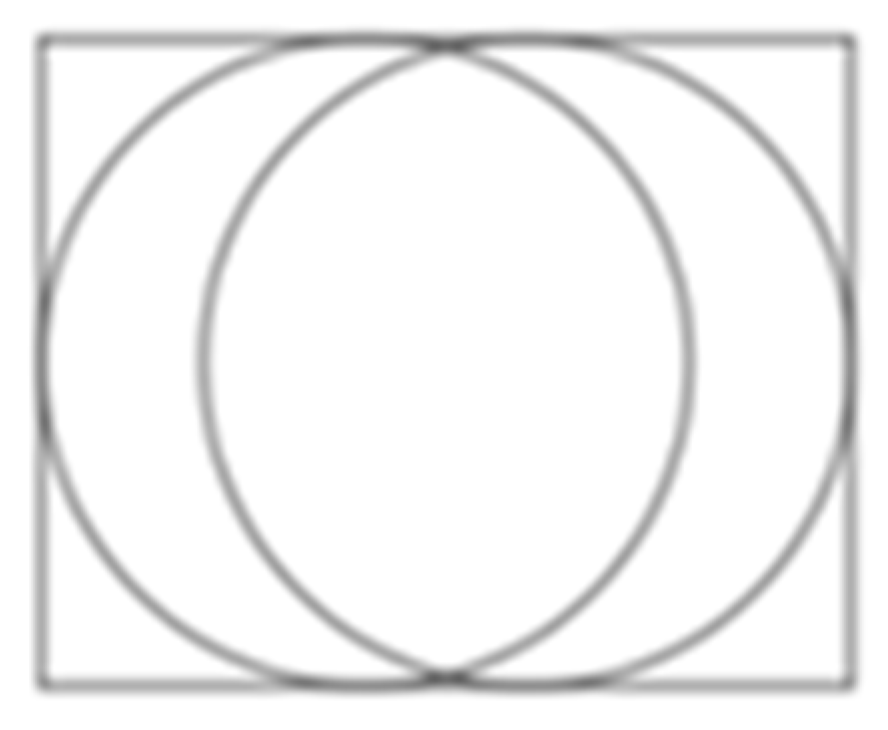
2.2.3. Problem 2
2.3. Research Sample 2—Outdoor Activities
Research Tools
- Activity 1: Draw a line segment 6 m long;
- Activity 2: Construct a perpendicular to the line segment from Activity 1;
- Activity 3: Mark out a site for a swimming pool with a diameter of 7 m;
- Activity 4: Mark out a site for a gazebo with a 5 m long square base.
3. Data Analysis of Indoor Problems
3.1. Problem 1 with Regard to Pupils’ Solutions
3.2. Problem 2 with Regard to Pupils’ Solutions
4. A Priori Analysis of the Activity and Teacher Preparation for Working with Pupils in Out-of-School Learning
4.1. A Priori Analysis of the Activities
4.1.1. Characteristics of Activity Assignments
4.1.2. Thematic Unit Where the Task Can Be Classified
4.1.3. Activity Goal
4.1.4. Problem-Solving Time Range
4.1.5. Course of Work
4.1.6. Tools
4.1.7. Didactic Variables for a Priori Analysis
4.1.8. Pupils’ Initial Knowledge and Skills
4.1.9. Pupils’ Reactions
4.1.10. Teachers’ Reactions
4.1.11. Problem-Solving Strategies
- Use the correct lengths (for a segment, diameter of a circle, sides of a square);
- Use the following properties: parallel lines, perpendiculars, radius, and diameter;
- Correctly display a circle with its geometric properties (definition, a set of points in a plane, center, radius, diameter);
- Correctly display a square with its geometric properties (definition, all sides are equal, opposite sides are parallel, adjacent sides are perpendicular);
- Use only tools such as paper, pen, chalk, string, a long measuring tape, and a line ruler.
4.1.12. Incorrect Problem-Solving Strategies
- Confuse the terms as radius and diameter, parallel lines, and perpendiculars;
- Not know how to use circles to construct the perpendicular to a segment;
- Not be able to draw a square without using a ruler and protractor;
- Not be able to use only the tools listed to construct a circle perpendicular to the segment and then a square.
4.1.13. Assessment of the Problem Task
5. Results and Reflections from a Priori Problem Solving
5.1. Activity 1—Draw a Line Segment 6 m Long
5.2. Activity 2—Construct a Perpendicular to the Line Segment from Activity 1
5.3. Activity 3—Mark out a Site for a Swimming Pool with a Diameter of 7 m
5.4. Activity 4—Mark out a Site for a Gazebo with a 5 m Long Square Base
6. Discussion and Conclusions
Author Contributions
Funding
Informed Consent Statement
Data Availability Statement
Conflicts of Interest
References
- Blum, W.; Ferri, R.B. Mathematical Modelling: Can It Be Taught and Learnt? J. Math. Model. Appl. 2009, 1, 45–58. [Google Scholar]
- Lingefjärd, T.; Holmquist, M. To assess students’ attitudes, skills and competencies in mathematical modeling. Teach. Math. Its Appl. Int. J. IMA 2005, 24, 123–133. [Google Scholar] [CrossRef]
- Wilson, K.J.; Long, T.M.; Momsen, J.L.; Speth, E.B. Modeling in the Classroom: Making Relationships and Systems Visible. CBE—Life Sci. Educ. 2020, 19, fe1. [Google Scholar] [CrossRef] [PubMed]
- Erbas, A.K.; Kertil, M.; Çetinkaya, B.; Cakiroglu, E.; Alacaci, C.; Bas, S. Mathematical modeling in mathematics education: Basic concepts and approaches. Educ. Sci. Theory Pract. 2014, 14, 1621–1627. [Google Scholar] [CrossRef]
- Arseven, A. Mathematical Modelling Approach in Mathematics education. Univers. J. Educ. Res. 2015, 3, 973–980. [Google Scholar] [CrossRef]
- Kertil, M. Matematik Öğretmen Adaylarının Problem Çözme Becerilerinin Modelleme Sürecinde İncelenmesi. Master’s Thesis, Institute of Education Sciences, Marmara University, Istanbul, Turkey, 29 January 2008. [Google Scholar]
- Blum, W.; Niss, M. Applied mathematical problem solving, modelling, applications, and links to other subjects? State, trends and issues in mathematics instruction. Educ. Stud. Math. 1991, 22, 37–68. [Google Scholar] [CrossRef]
- Dundar, S.; Gokkurt, B.; Soylu, Y. Mathematical modelling briefly: A theoretical study. Procedia-Soc. Behav. Sci. 2012, 46, 3465–3470. [Google Scholar] [CrossRef]
- Rea, T.; Waite, S. International perspectives on outdoor and experiential learning. Int. J. Prim. Elem. Early Years Educ. 2009, 37, 1–4. [Google Scholar] [CrossRef]
- Altuntas, M.; Cetin, I. Discovering mathematics beyond the classroom: An investigation of secondary- school students’ experiences of mathematics in outdoor learning environments. J. Innov. Res. Teach. Educ. 2023, 4, 336–357. [Google Scholar] [CrossRef]
- Moss, M. Outdoor Mathematical Experiences: Constructivism, Connesctions, and Healt. In Tasks in Primary Mathematics Education; Clarke, B., Grevholm, B., Millman, R., Eds.; Springer: New York, NY, USA, 2009; pp. 236–274. [Google Scholar]
- Ullmann, P. Some Remarks on “Good” Tasks in Mathematical Outdoor Activities. In Research on Outdoor STEM Education in the DIgital Age, Proceedings of the ROSETA Online Conference, Online, 10 June 2020; WTM: Munster, Germany, 2020; pp. 171–178. [Google Scholar]
- Pambudi, D.S. The Effect of Outdoor Learning Method on Elementary Students’ Motivation and Achievement in Geometry. Int. J. Instr. 2022, 15, 747–764. [Google Scholar] [CrossRef]
- Wang, C.K.J.; Ang, R.P.; Teo-Koh, S.M.; Kahlid, A. Motivational predictors of young adolescents’ participation in an outdoor adventure course: A self-determination theory approach. J. Adventure Educ. Outdoor Learn. 2004, 4, 57–65. [Google Scholar] [CrossRef]
- Becker, C.; Lauterbach, G.; Spengler, S.; Dettweiler, U.; Mess, F. Effects of Regular Classes in Outdoor Education Settings: A Systematic Review on Students’ Learning, Social and Health Dimensions. Int. J. Environ. Res. Public Health 2017, 14, 485. [Google Scholar] [CrossRef] [PubMed]
- Dofková, R. Outdoorová výuka matematiky jako alternativní didaktický instrument. In Reflexe Vzdělávacích Potřeb Učitelů Matematiky Jako Východisko Jejich Profesního Rozvoje, 1st ed.; Bártek, D., Ed.; Univerzita Palackého v Olomouci: Olomouc, Czech Republic, 2017; pp. 195–216. [Google Scholar]
- Česková, T.; Svobodová, H.; Mísařová, D.; Durna, R.; Hofmann, E. Koncepce Terénní Výuky pro Základní Školy: Na Příkladu Námětů pro Krátkodobou a Střednědobou Terénní Výuku Vlastivědného a Zeměpisného Učiva; Masarykova Univerzita: Brno, Czech Republic, 2019; p. 49. [Google Scholar]
- Fägerstam, E.; Samuelsson, J. Learning arithmetic outdoors in junior high school—Influence on performance and self-regulating skills. Int. J. Prim. Elem. Early Years Educ. 2012, 42, 419–443. [Google Scholar] [CrossRef]
- Bicer, A.; Boedeker, P.; Capraro, R.M.; Capraro, M.M. The effects of STEM PBL on students’ mathematical and scientific vocabulary knowledge. Int. J. Contemp. Educ. Res. 2015, 2, 69–75. [Google Scholar]
- Karamustafaoğlu, O.; Pektaş, H.M. Developing students’ creative problem-solving skills with inquiry-based STEM activity in an out-of-school learning environment. Educ. Inf. Technol. 2022, 28, 7651–7669. [Google Scholar] [CrossRef]
- Mahoney, J.L.; Cairns, B.D.; Farmer, T.W. Promoting interpersonal competence and educational success through extracurricular activity participation. J. Educ. Psychol. 2003, 95, 409–418. [Google Scholar] [CrossRef]
- Mangiante-Orsola, C.; Perrin-Glorian, M.J.; Strømskag, H. Theory of didactical situations as a tool to understand and develop mathematics teaching practices. Ann. Didact. Sci. Cognitives. Rev. Int. Didact. Mathématiques 2018, 145–174. [Google Scholar] [CrossRef]
- Brousseau, G. Theory of Didactical Situations in Mathematics: Didactique des Mathématiques, 1970–1990; Springer Science & Business Media: Berlin/Heidelberg, Germany, 2006; Volume 19. [Google Scholar]
- Brousseau, G. Educación y didáctica de las matemáticas. Educ. Matemática 2000, 12, 5–38. [Google Scholar] [CrossRef]
- Chevallard, Y. Concepts fondamentaux de la didactique: Perspectives apportees par une approche anthropologique. Rech. En Didact. Math. 1992, 12, 73–112. [Google Scholar]
- Herbst, P.; Kilpatrick, J. “Pour Lire” Brousseau. Learn. Math. 1999, 19, 3–10. [Google Scholar]
- NUCEM. Testovanie 9—Priebeh, Výsledky a Analýzy, Years 2015–2019. Available online: https://www.nucem.sk/sk/merania/narodne-merania/testovanie-9 (accessed on 16 September 2024).
- Mason, M. Professional Handbook for Teachers, Geometry: Explorations and Applications; University of Virginia: Charlottesville, VA, USA; McDougal Littell Inc.: Boston, MA, USA, 2014; pp. 1–8. [Google Scholar]
- Van De Walle, J.A. Elementary School Mathematics: Teaching Developmentally, 4th ed.; Longman: New York, NY, USA, 2004; p. 478. [Google Scholar]
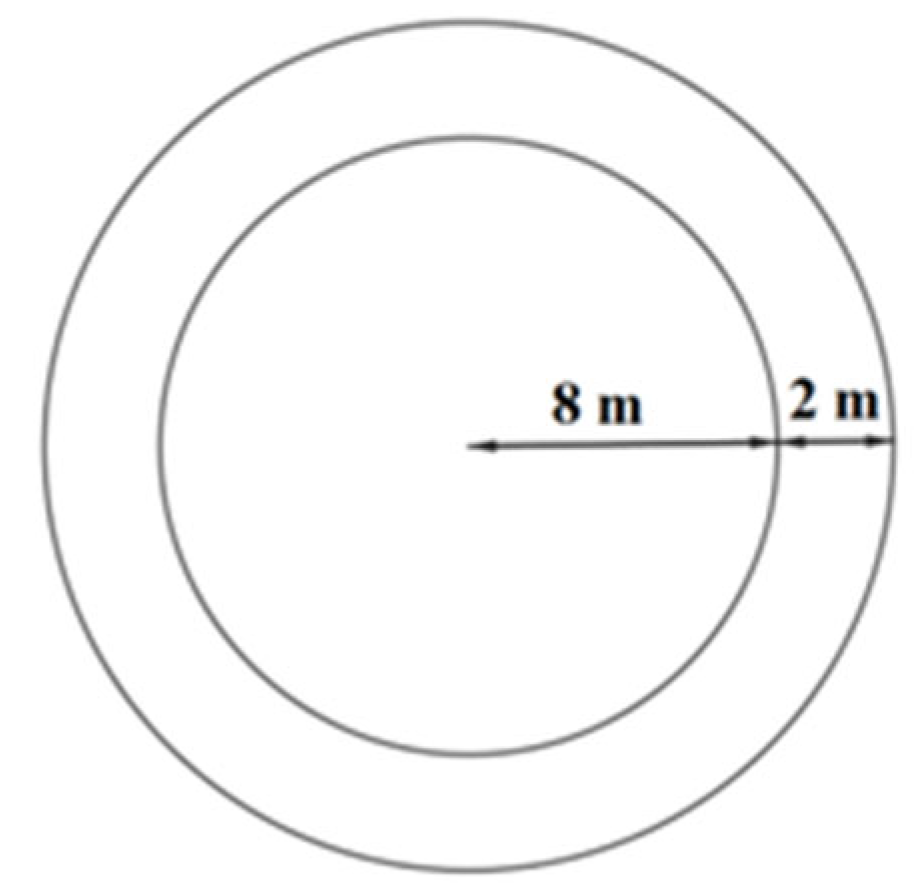
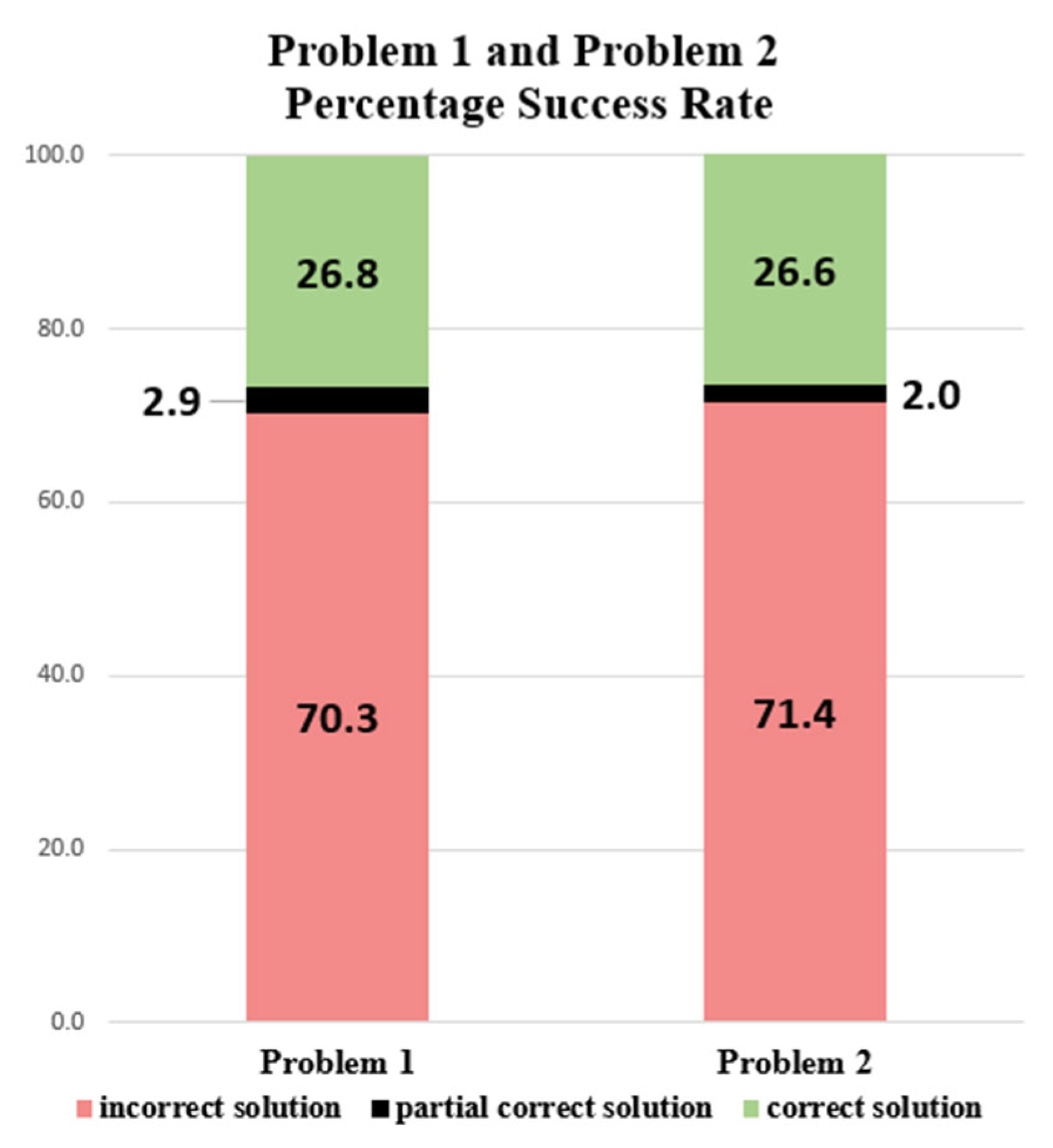

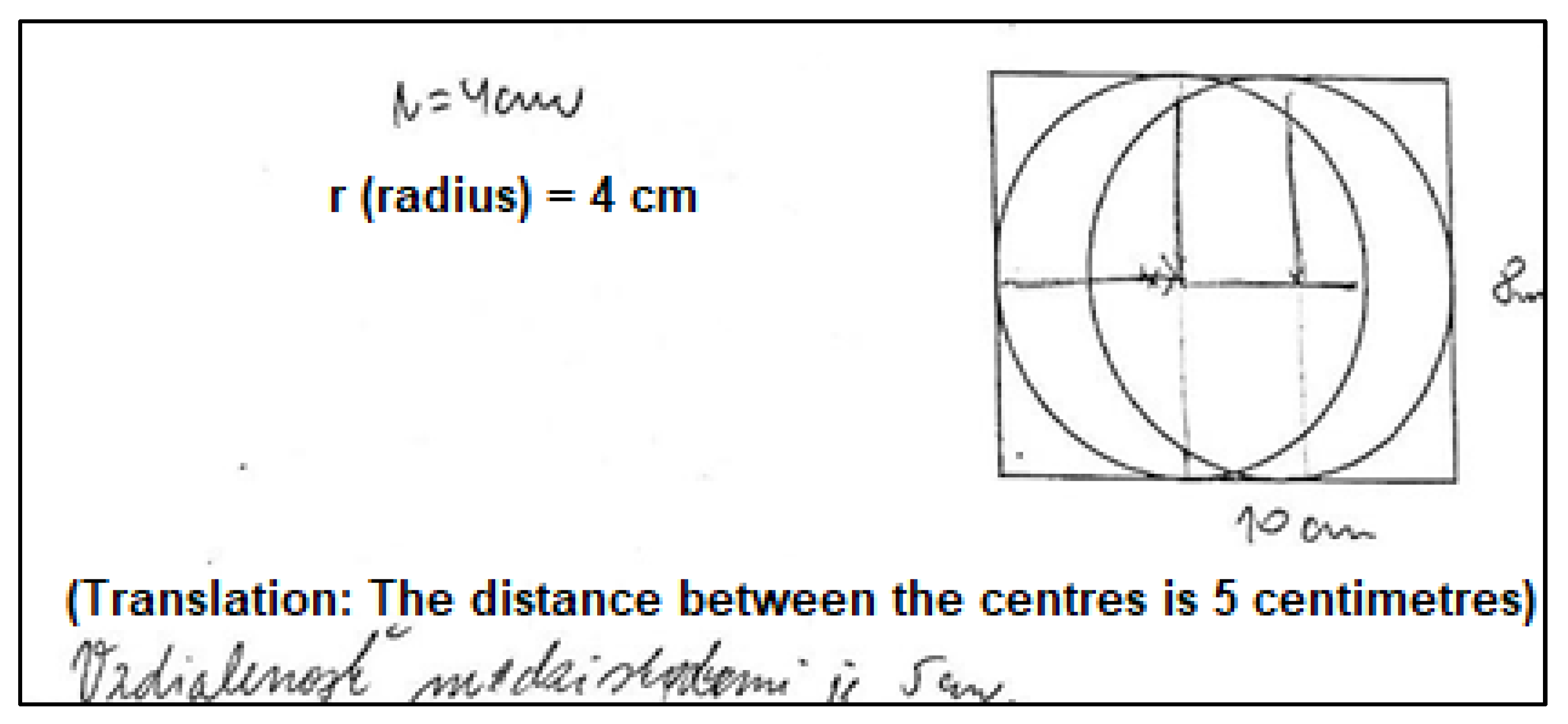
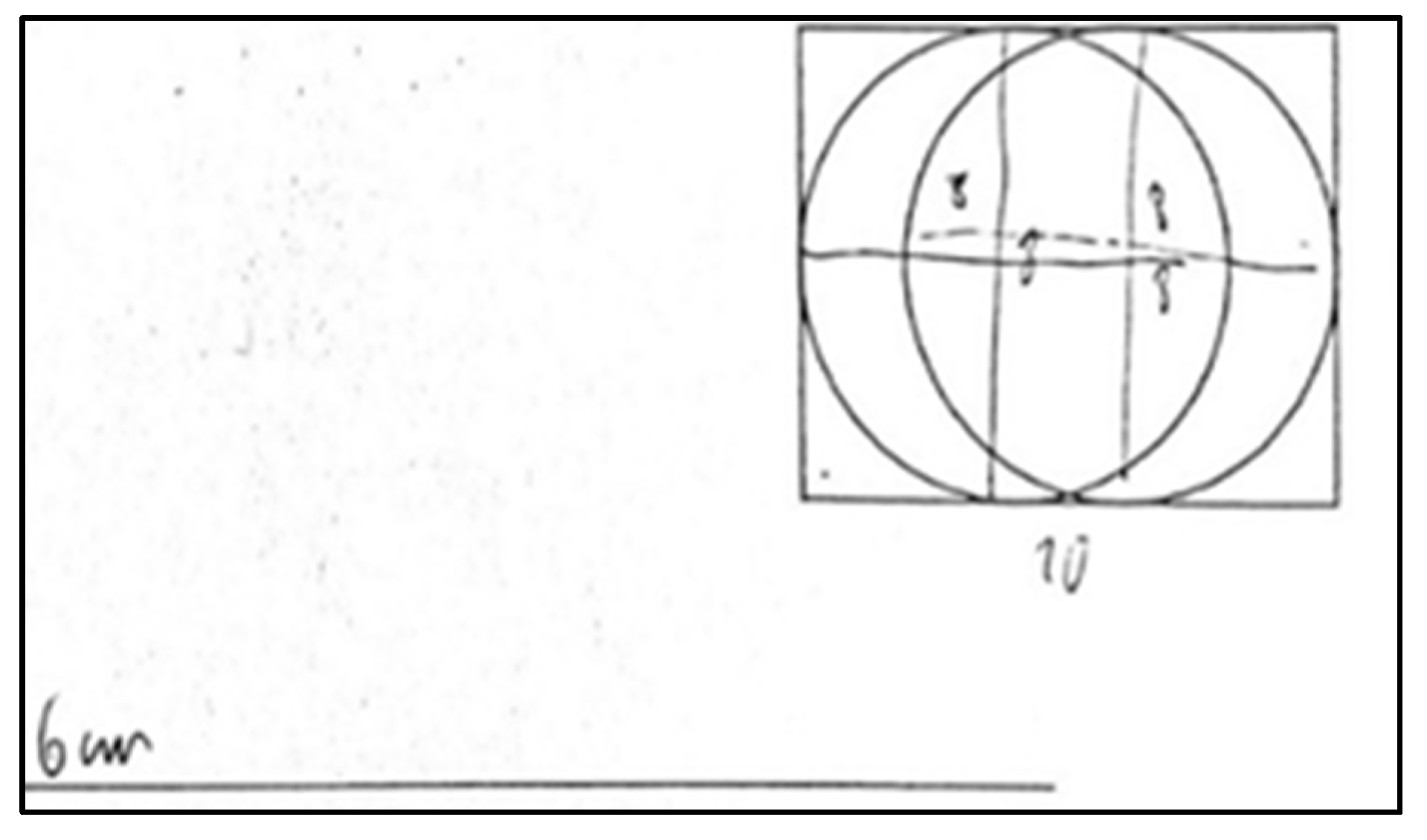



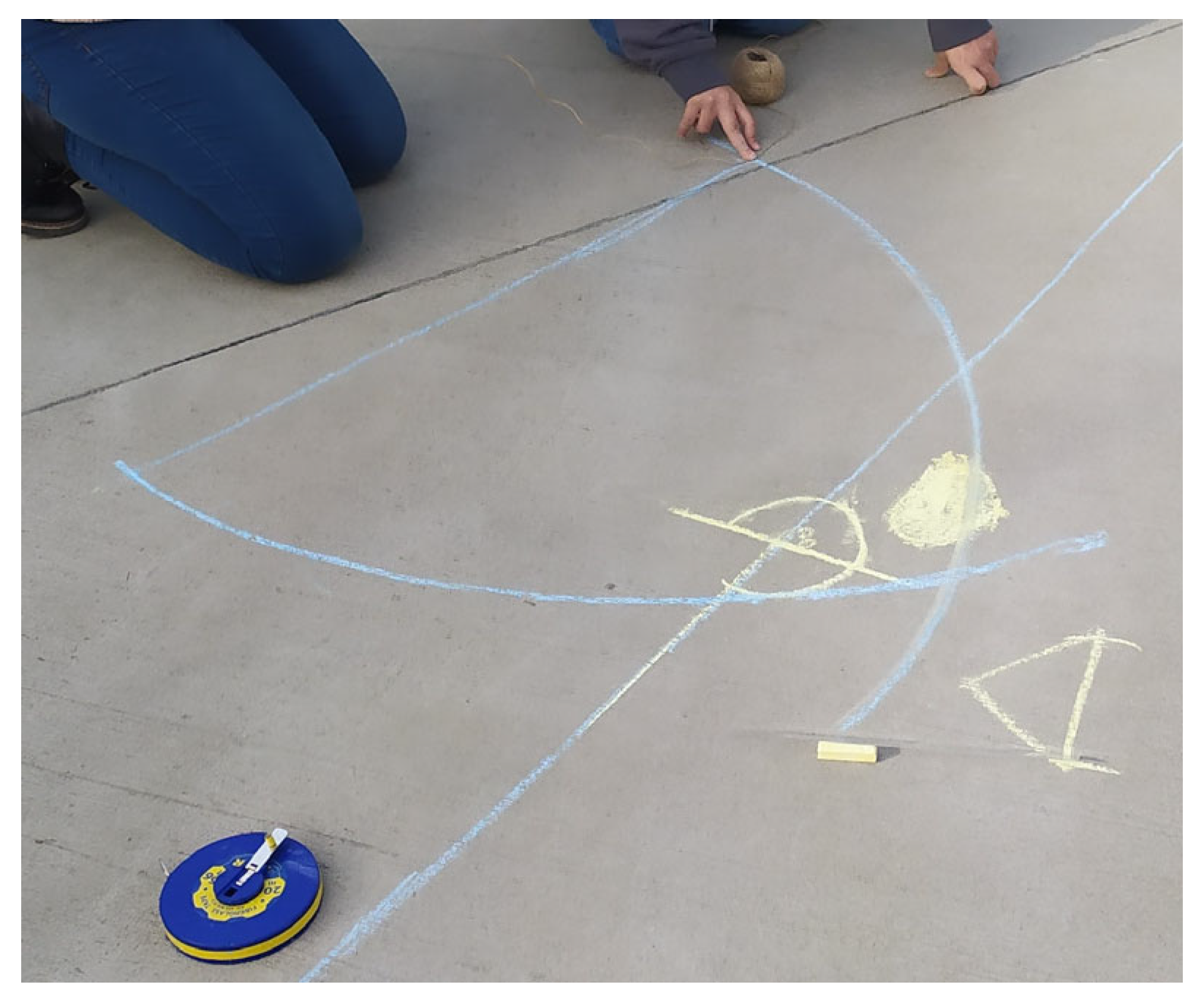
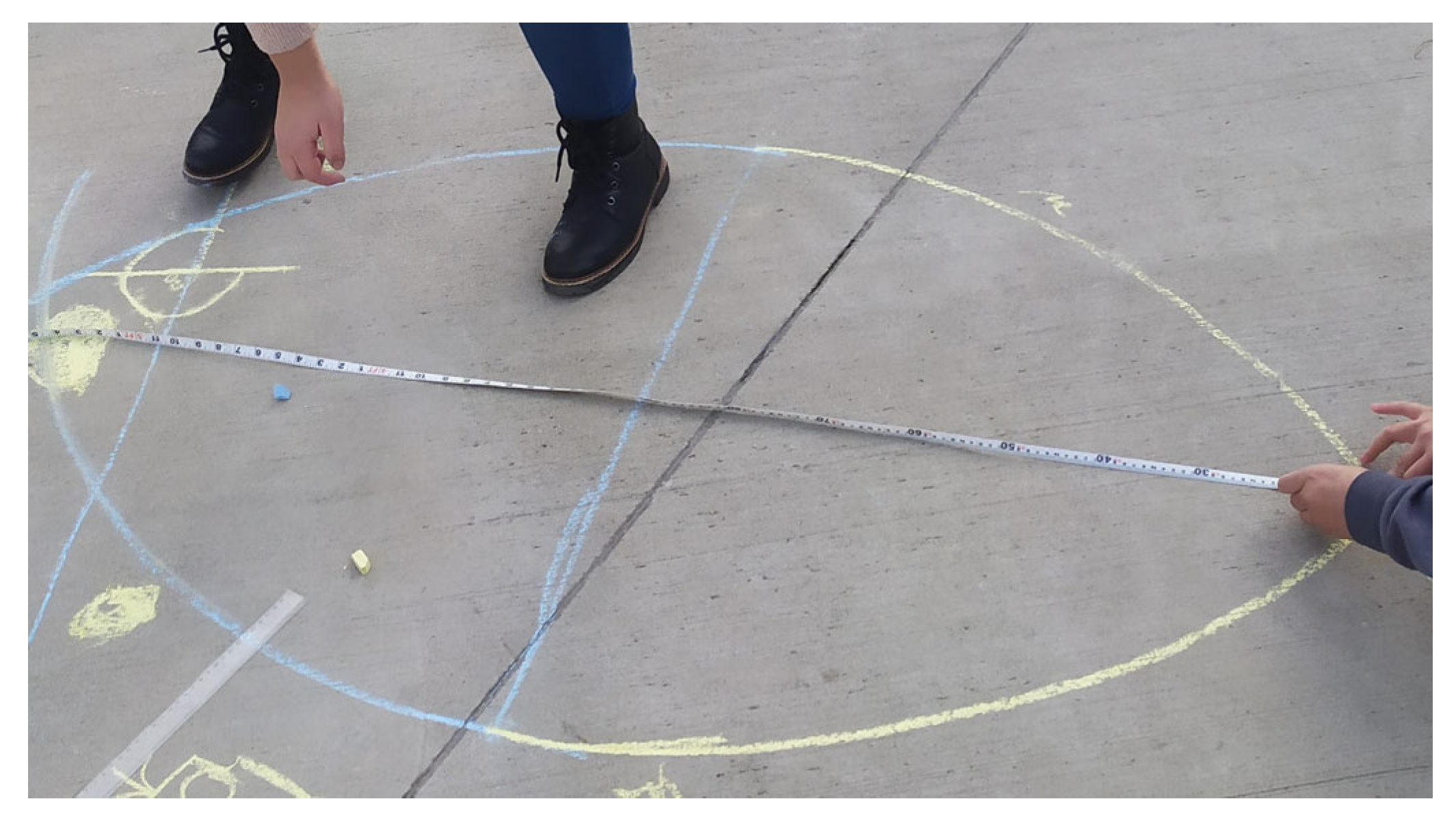

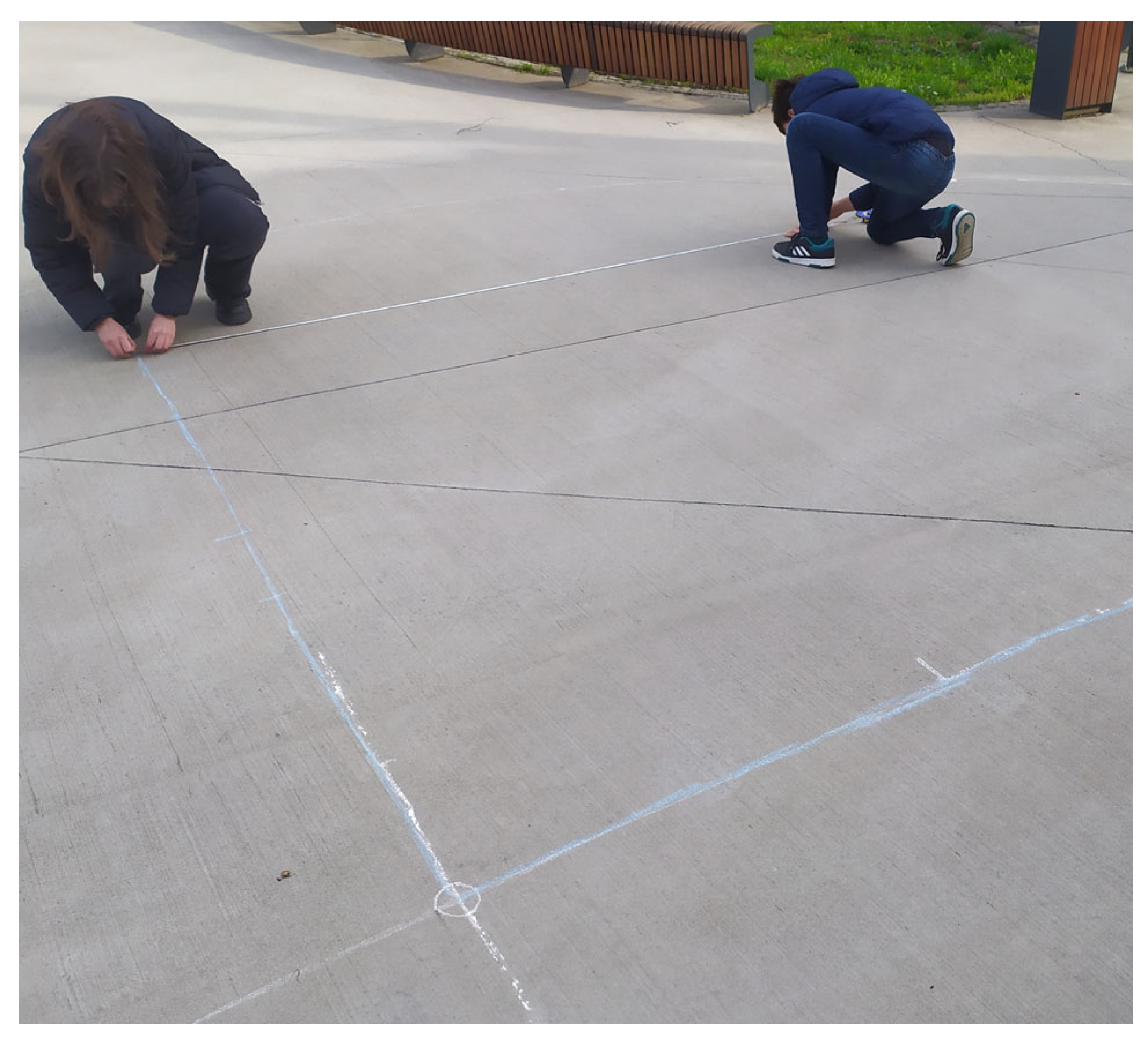
Disclaimer/Publisher’s Note: The statements, opinions and data contained in all publications are solely those of the individual author(s) and contributor(s) and not of MDPI and/or the editor(s). MDPI and/or the editor(s) disclaim responsibility for any injury to people or property resulting from any ideas, methods, instructions or products referred to in the content. |
© 2024 by the authors. Licensee MDPI, Basel, Switzerland. This article is an open access article distributed under the terms and conditions of the Creative Commons Attribution (CC BY) license (https://creativecommons.org/licenses/by/4.0/).
Share and Cite
Bočková, V.; Rumanová, L. Mathematical Modeling Approach and Exploration of Geometric Properties as Part of an Outdoor Activity for Primary-School Pupils in Out-of-School Learning. Educ. Sci. 2024, 14, 1304. https://doi.org/10.3390/educsci14121304
Bočková V, Rumanová L. Mathematical Modeling Approach and Exploration of Geometric Properties as Part of an Outdoor Activity for Primary-School Pupils in Out-of-School Learning. Education Sciences. 2024; 14(12):1304. https://doi.org/10.3390/educsci14121304
Chicago/Turabian StyleBočková, Veronika, and Lucia Rumanová. 2024. "Mathematical Modeling Approach and Exploration of Geometric Properties as Part of an Outdoor Activity for Primary-School Pupils in Out-of-School Learning" Education Sciences 14, no. 12: 1304. https://doi.org/10.3390/educsci14121304
APA StyleBočková, V., & Rumanová, L. (2024). Mathematical Modeling Approach and Exploration of Geometric Properties as Part of an Outdoor Activity for Primary-School Pupils in Out-of-School Learning. Education Sciences, 14(12), 1304. https://doi.org/10.3390/educsci14121304







